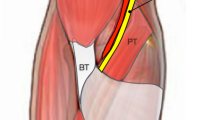Summary
The anatomy of the carpal tunnel was studied by postmortem dissection of both wrists in ten adults with normal wrists. Preoperative clinical and EMG examinations were performed on 28 wrists in 23 patients suffering from carpal tunnel syndrome. Anatomical and histological studies were made in connection with operation, and postoperatively the condition was followed clinically and by EMG. Numbness, tingling, and pain of the hands were markedly relieved during 2 months of follow-up, whereas clumsiness and weakness showed no significant change. Preoperatively, EMG showed sensory abnormalities in 96% of cases and motoric abnormalities in 82%. The diagnostic accuracy of EMG was good, in particular as regards the sensory aspect. The return to normal of EMG was slow. Pathoanatomical examination showed a normal tendon sheath and transverse carpal ligament in 52%, while rheuma was found in the specimens of 12%, fibrosis of the tendon sheath in 36%, and fibrosis of the transverse carpal ligament in 32%. No correlation was observed between the shape of the osseous carpal tunnel and the degree of clinical symptoms.
Zusammenfassung
Anhand von Autopsien bei 10 Erwachsenen (20 Gelenke) mit normalen Handgelenken wurde die Anatomie des Karpaltunnels untersucht. Bei 23 Patienten (28 Gelenke) mit Karpaltunnelsyndrom wurde präoperativ neben der klinischen Untersuchung ein EMG abgeleitet. Anatomische und histologische Studien wurden im Zusammenhang mit der Operation durchgeführt, postoperativ erfolgte die Kontrolle des EMG-Befundes. Im Ergebnis der Operation waren nach 2monatiger postoperativer Beobachtungszeit Hypästhesie, Parästhesie und Schmerz erheblich vermindert, während Störungen der Feinmotorik sowie Muskelschwäche keine signifikanten Veränderungen zeigten. Das präoperative EMG ergab sensible Störungen in 96% und motorische Störungen in 82% der Fälle. Das EMG erwies sich besonders bezüglich der Sensibilität als diagnostisch zuverlässig. Die Normalisierung des EMG-Befundes erfolgte langsam. Das Ergebnis der pathologisch-anatomischen Untersuchung des peritendinösen Syniovialgewebes sowie des Ligamentum carpi transversum war bei 52% normal, Rheuma wurde bei 12% der Präparate gefunden, Fibrosis des Sehnengleitgewebes bei 36%, Fibrosis des Ligamentum carpi transversum bei 32%. Zwischen der Form des knöchernen Karpaltunnels und dem Schweregrad der klinischen Symptome konnte kein Zusammenhang festgestellt werden.
Similar content being viewed by others
References
Ariyan S, Watson HK (1977) The palmar approach for the visualization and release of the carpal tunnel. An analysis of 429 cases. Plast Reconstr Surg 60 [4]:539–547
Barranco SD, Strelka EP (1976) Carpal tunnel syndrome. Va Med 103:122–124
Cseuz KA, Thomas JE, Lambert EH, Love JG, Libscomb PR (1966) Long-term results of operation for carpal tunnel syndrome. Mayo Clin Proc 41:232–241
Gainer JV, Nugent GR (1977) Carpal tunnel syndrome: report of 430 operations. South Med J 70:325–328
Gassmann N, Segmüller G (1976) Das Karpaltunnelsyndrom: Indikation und Technik der epineuralen und der interfaszikulären Neurolyse. Helv Chir Acta 43:699–702
Hybbinette C-H, Mannerfelt L (1975) The carpal tunnel syndrome. A retrospective study of 400 operated patients. Acta Orthop Scand 46:610–620
Inglis AE, Straub LR, Williams CS (1972) Median nerve neuropathy at the wrist. Clin Orthop 83:48–54
Iyer V, Fenichel GM (1976) Normal median nerve proximal latency in carpal tunnel syndrome: a clue to coexisting Martin-Gruber anastomosis. J Neurol Neurosurg Psychiatry 39:449–452
Kopell HP, Thompson WAL (1963) Peripheral entrapment neuropathies. Williams & Wilkins, Baltimore
Kreuzer KB, Haussmann P (1979) Ungewöhnliche Ursachen des Karpaltunnelsyndroms. Handchirurgie 11: 173–175
LaBan MM, Zemenick GA, Meerschaert JR (1975) Neck and shoulder pain. Presenting symptoms of carpal tunnel syndrome. Mich Med 74:549–550
Langloh ND (1976) Karpaltunnel-Syndrom unter Berück-sichtigung des Rezidivs nach operativer Behandlung. Fortschr Med 94:136–138
Langloh ND, Linscheid RL (1972) Recurrent and unrelieved carpal tunnel syndrome. Clin Orthop 83:41–47
Latreille J-M, Leclaire R (1976) Le syndrome du canal carpien, étude clinique et électrodiagnostique. Union Med Can 105:710–719
Moermans JP, Demey A, Durdu J (1977) Résultats du traitement chirurgical du syndrome du canal carpien. Acta Orthop Belg 43:191–199
Phalen GS (1966) The carpal tunnel syndrome. Seventeen years' experience in diagnosis and treatment of six hundred fifty-four hands. J Bone Joint Surg [Am] 48:211–228
Phalen GS (1972) The carpal tunnel syndrome. Clinical evaluation of 598 hands. Clin Orthop 83:29–40
Robbins H (1963) Anatomical study of the median nerve in the carpal tunnel and etiologies of the carpal-tunnel syndrome. J Bone Joint Surg [Am] 45:953–966
Tanzer RC (1959) The carpal tunnel syndrome. A clinical and anatomical study. J Bone Joint Surg [Am] 41:626–634
Author information
Authors and Affiliations
Rights and permissions
About this article
Cite this article
Pätiälä, H., Rokkanen, P., Kruuna, O. et al. Carpal tunnel syndrome. Arch. Orth. Traum. Surg. 104, 69–73 (1985). https://doi.org/10.1007/BF00454239
Received:
Issue Date:
DOI: https://doi.org/10.1007/BF00454239




